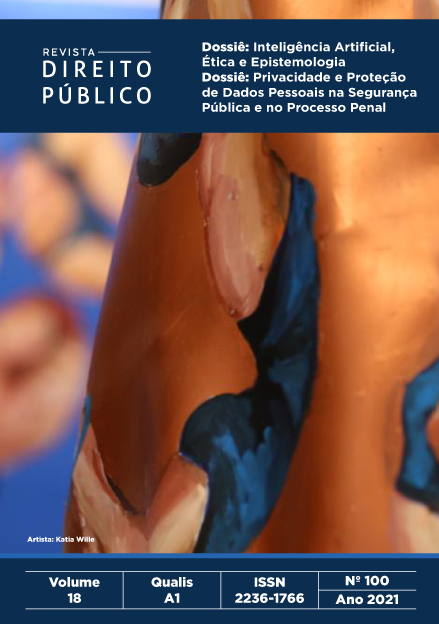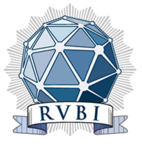Vigilância e Relações de Poder – O Uso de Tecnologias de Reconhecimento Facial e Identificação Biométrica a Distância em Espaço Público e Impactos na Vida Pública
DOI:
https://doi.org/10.11117/rdp.v18i100.6203Palavras-chave:
Reconhecimento facial, inteligência artificial (IA), vigilância, espaço público, vida pública.Resumo
Os conceitos de espaço público e vida pública são abordados sob uma perspectiva espácio-antropológica com o objetivo de refletir sobre possíveis impactos da implementação de tecnologias de vigilância intrusivas. A vigilância massiva de espaços públicos impacta sobre a privacidade individual e as relações de poder estabelecidas, mas torna-se justificável sob o argumento de que garante a sua segurança e é utilizada para a manutenção da ordem pública. Em consequência, sistemas tecnológicos de crescente complexidade vêm sendo desenvolvidos e implementados em cidades por todo o mundo. A reflexão sobre impactos da implementação de sistemas de vigilância baseados em tecnologias de inteligência artificial (IA) inclui questões éticas relacionadas com valores culturais e direitos adquiridos, sendo questionado o uso de tecnologias de reconhecimento facial e identificação biométrica para a identificação de indivíduos em espaços publicamente acessíveis com base nos princípios de transparência, autonomia, proporcionalidade e equidade.
Downloads
Referências
AGIER, M. Antropologia da cidade: lugares, situações, movimentos. São Paulo: Terceiro Nome, 2011.
ARENDT, H. The human condition. Chicago: University of Chicago Press, 1958.
BAUDELAIRE, C. O spleen de Paris: pequenos poemas em prosa. Lisboa: Relógio d’Água, v. [1869], 1991.
BENJAMIN, W. Obras escolhidas III: Charles Baudelaire, um lírico no auge do capitalismo. São Paulo: Brasiliense, 1991.
COM. Ethics guidelines for trustworthy AI. European Commission: 2019.
COM. Laying down harmonised rules on artificial intelligence (Artificial Intelligenc Act) and mending certain union legislative acts. European Commission, 2021.
DAMATTA, R. A casa & a rua. Espaço, cidadania, mulher e morte no Brasil. 5. ed. Rio de Janeiro: Rocco Digital, 1997.
DITTON, J.; SHORT, E. Yes, it works, no, it doesn’t: comparing the effects of open-street CCTV in two adjacent Scottish Town Centres. In: CLIVE NORRIS, D. W. Surveillance, crime and social control. [s.l.]: Routledge, p. 201-223, 2006.
EDPB EDPS. Joint opinion on the proposal for a Regulation of the European Parliament and of the Council laying down harmonised rules on artificial intelligence (Artificial Intelligence Act). 2021.
EU. General Data Protection Regulation – Regulation (EU) 2016/679. 2016.
FLORIDI, L. et al. AI4People – An ethical framework for a good AI society: opportunities, risks, principles, and recommendations. Minds and Machines, v. 28, p. 689-707, 2018.
______ et al. How to design AI for social good: seven essential factors. Science and Engineering Ethics, v. 26, p. 1771-1796, 2020.
FLORINI, A. M. The battle over transparency. In: FLORINI, A. M. The right to know: transparency for an open world. New York: Columbia University Press, p. 1-16, 2007.
FONTES, A. C. As pequenas escalas da rua. Tese de Doutoramento em Estudos Urbanos. ISCTE-IUL e FCSH-UNL, 2020.
FOUCAULT, M. Discipline and punish: the birth of the prison. New York: Random House, 1979.
FYFE, N. R.; BANNISTER, J. “The eyes upon the street”: closed-circuit television surveillance and the city. In: FYFE, N. R. Images of the street: representation, experience and control in public space. London: Routledge, p. 254-267, 1998.
GEHL, J.; GEMZøE, L. New city spaces. The Danish Architectural Press, 2001.
HABERMAS, J. Espace public. Paris: Payot, 1978.
HABRAKEN, N. J. The structure of the ordinary. Form and Control in the Built Environment. Massachusetts: MIT Press, 1998.
HANNERZ, U. Exploring the city. Inquires toward an urban anthropology. New York Chichester: Columbia University Press, 1980.
JACOBS, J. Death and life of great American cities. New York: Random House, 1961. [1961].
JINU, C.; SHEEJA, A. A. Face recognition in CCTV systems. 2019 International Conference on Smart Systems and Inventive Technology (ICSSIT), 2019.
KAMGAR-PARSI, B.; LAWSON, W.; KAMGAR-PARSI, B. Toward development of a face recognition system for watchlist surveillance. IEEE Transactions on Pattern Analysis and Machine Intelligence, v. 33, n. 10, 2011.
KOSKELA, H. “The gaze without eyes”: video-surveillance and the changing nature of urban space. Progress in Human Geography, v. 24, n. 2, p. 243-265, 2000.
KOSKELA, H. “Cam Era” – The contemporary urban panopticon. Surveillance & Society, v. 1, n. 3, p. 292-313, 2003.
LEFEBVRE, H. The production of space. Oxford UK e Cambridge USA: Blackwell, 1991.
LYON, D. Surveillance society. Monitoring everyday life. Buckingham and Philadelphia: Open University Press, 2001.
MADANIPOUR, A. Public and private spaces of the city. Routledge, 2003.
MADANIPOUR, A. Introduction. In: MADANIPOUR, A. Whose public space? International case studies in urban design and development. Abingdon and New York: Routledge, p. 1-15, 2010.
MITCHELL, D. The end of public space: people’s park, definitions of the public and democracy. Annals of the Association of American Geographers, v. 85, p. 108-33, 1995.
NORRIS, C.; ARMSTRONG, G. CCTV and the social structuring of surveillance. In: NORRIS, C.; WILSON, D. Surveillance, crime and social control. Routledge, p. 157-178, 2006.
ROO, M. S. Human activity prediction: early recognition of ongoing activities from streaming videos. IEEE International Conference on Computer Vision, Barcelona, 2011.
SENNETT, R. The fall of public man: on the social psychology of capitalism. New York: Random House, 1977.
SI, W. et al. Remote identity verification using gait analysis and face recognition. Wireless Communications and Mobile Computing, 2020.
SIMMEL, G. A metrópole e a vida mental. In: VELHO, O. O fenômeno urbano. Rio de Janeiro: Zahar, 1973. [1950].
SQUIRES, J. Private lives, seculed places: privacy as a polical possibility. Environment and Planning D: Society and Space, v. 12, n. 390, 1994.
TADDEO, M.; FLORIDI, L. How AI can be a force for good. Science, v. 361, n. 6404, p. 751-752, 2018.
TAYLOR, N. State surveillance and the right to privacy. Surveillance & Society, v. 1, n. 1, p. 66-85, 2002.
UNITED NATIONS. Universal Declaration of Human Rights. General Assembly Resolution 217 A, 1948.
WESTIN, A. F. Privacy and freedom. Wash. & Lee L. Rev., v. 25, n. 1, 1968.
Publicado
Como Citar
Edição
Seção
Licença
Copyright (c) 2022 Direito Público

Este trabalho está licenciado sob uma licença Creative Commons Attribution-NonCommercial 4.0 International License.
O(s)/A(s) autores(as) dos manuscritos submetidos concorda(m) com as regras a seguir:
1) Todos os autores e autoras participaram do trabalho, são responsáveis pelas ideias e conceitos nele emitidos e atestam sua conformidade com os princípios éticos exigidos.
2) Todos os autores e autoras concordam com a forma final do trabalho e em ceder os direitos para publicação nos canais de publicação da Escola de Direito do IDP.
3) Todos os autores e autoras informam que o manuscrito é de sua autoria e assumem a responsabilidade pelo trabalho, declarando que a obra a ser publicada não infringe quaisquer direitos de propriedade intelectual de terceiros.
3.1) Em caso de submissão simultânea, além da reprovação imediata do artigo e comunicação ao(s) respectivo(s) periódico(s), a Revista Direito Público se reserva o direito de não receber novas submissões de todos os autores implicados pelo prazo de 2 (dois) anos, contado a partir da data de ciência do fato.
4) Todos os autores e autoras autoriza(m) a edição de seu trabalho e cede(m) à Escola de Direito do IDP os direitos de autor para reproduzir, editar e publicar ou veicular o citado trabalho em qualquer forma midiática, resguardada a autoria, em particular sob forma digital, em arquivo eletrônico online na Internet, bem como armazená-los em seu repositório de acordo com o desenvolvimento do processo editorial. Esta concessão não terá caráter oneroso para a Escola de Direito do IDP, não havendo remuneração sob qualquer modalidade pela utilização do referido material, tendo este o caráter de colaboração científica.












